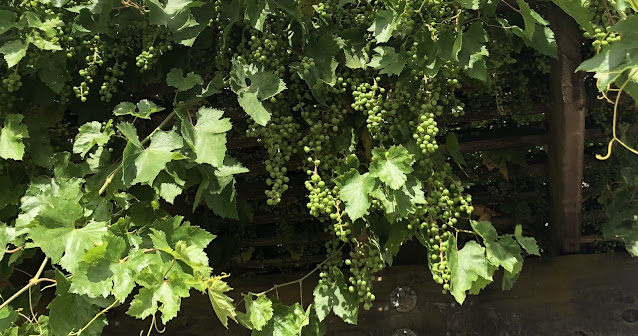
Clouds to provide some relief from triple-digit heat

|
|
Growing grapes? Thin them now for bigger, better clusters later. (Photo:
Kathy Morrison)
|
Clouds are coming to our rescue – and maybe a little rain, too!
After two days of excessive heat, some possible showers and the cloud cover that comes with them are expected to cool Sacramento down several degrees.
According to the National Weather Service, Sacramento has a 30% chance of rain Sunday morning, followed by breezy conditions through Monday. Instead of triple-digit afternoons, our highs will hover in the mid 80s.
Once the breeze dies down, the temperatures will begin to climb again, peaking just below 100 on Wednesday. Then, another dip back into the 80s is expected by next weekend, says the weather service.
In case you’re wondering, the hottest June day in Sacramento history: 115 degrees. So, a mix of 80s and 90s isn’t so bad.
Expect more odd behavior from plants during these yo-yo temperatures. The important thing is to keep soil from drying out completely; mulch works wonders for retaining moisture and keeping roots comfortable. To avoid evaporation, water early in the morning.
Watch out for heat stress – both for you and your pets and plants. When temperatures climb, retreat inside.
* Let the grass grow longer. Set the mower blades high to reduce stress on your lawn during summer heat. To cut down on evaporation, water your lawn deeply during the wee hours of the morning, between 2 and 8 a.m.
* Tie up vines and stake tall plants such as gladiolus and lilies. That gives their heavy flowers some support.
* Dig and divide crowded bulbs after the tops have died down.
* Feed summer flowers with a slow-release fertilizer. Remember to water first.
* Avoid pot “hot feet.” Place a 1-inch-thick board under container plants sitting on pavement. This little cushion helps insulate them from radiated heat.
* Thin grapes on the vine for bigger, better clusters later this summer.
* Cut back fruit-bearing canes on berries.
*Warm weather brings rapid growth in the vegetable garden, with tomatoes and squash enjoying the heat. Deep-water, then feed with a balanced fertilizer. Bone meal can spur the bloom cycle and help set fruit.
* Generally, tomatoes need deep watering two to three times a week, but don’t let them dry out completely. That can encourage blossom-end rot
* Feed camellias, azaleas and other acid-loving plants. Mulch to conserve moisture and reduce heat stress.
* Plant basil to go with your tomatoes. There’s still time to plant radishes, sunflowers, melons, pumpkins and squash from seed.
* Transplant summer annuals such as petunias, marigolds and zinnias.
* Transplant perennial flowers including astilbe, columbine, coneflowers, coreopsis, dahlias, rudbeckia, salvia and verbena.
Comments
0 comments have been posted.Sacramento Digs Gardening to your inbox.
Sites We Like
Garden Checklist for week of May 5
Survey your garden after the May 4 rainstorm. Heavy rain and gusty winds can break the neck of large flowers such as roses. Also:
* Keep an eye on new transplants or seedlings; they could take a pounding from the rain.
* Watch out for powdery mildew. Warmth following moist conditions can cause this fungal disease to “bloom,” too. If you see a leaf that looks like it’s dusted with powdered sugar, snip it off.
* After the storm, start setting out tomato transplants, but wait on the peppers and eggplants (they want warmer nights). Pinch off any flowers on new transplants to make them concentrate on establishing roots instead of setting premature fruit.
* Trim dead flowers but not leaves from spring-flowering bulbs such as daffodils and tulips. Those leaves gather energy to create next year's flowers. Also, give the bulbs a fertilizer boost after bloom.
* Pinch chrysanthemums back to 12 inches for fall flowers. Cut old stems to the ground.
* Mulch around plants to conserve moisture and control weeds.
* From seed, plant beans, beets, cantaloupes, carrots, corn, cucumbers, melons, pumpkins, radishes and squash.
* Plant onion sets.
* In the flower garden, plant seeds for asters, cosmos, celosia, marigolds, salvia, sunflowers and zinnias. Transplant petunias, zinnias, geraniums and other summer bloomers.
* Plant perennials and dahlia tubers for summer bloom.
* Don’t wait; plant summer bulbs, such as gladiolus and tuberous begonias.
* Harvest cabbage, lettuce, peas and green onions.